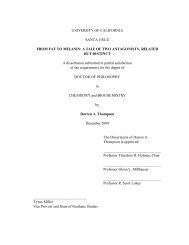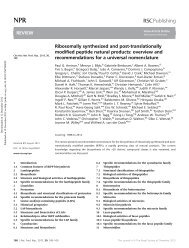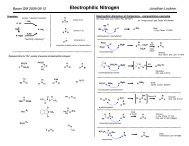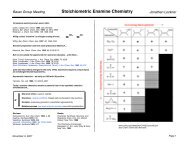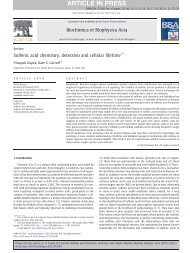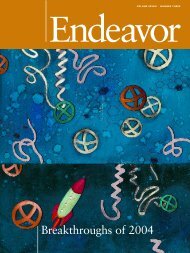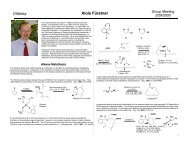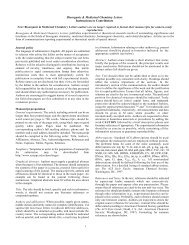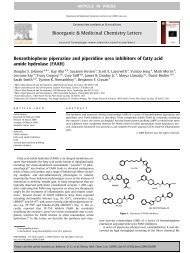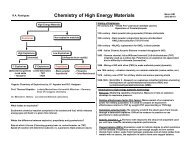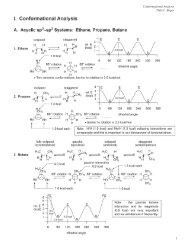The biosynthetic gene cluster for the antitumor drug bleomycin from ...
The biosynthetic gene cluster for the antitumor drug bleomycin from ...
The biosynthetic gene cluster for the antitumor drug bleomycin from ...
Create successful ePaper yourself
Turn your PDF publications into a flip-book with our unique Google optimized e-Paper software.
Research Paper Bleomycin <strong>biosyn<strong>the</strong>tic</strong> <strong>gene</strong> <strong>cluster</strong> Du et al. 625<br />
natural products, it is imagined that hybrid NRPS^PKS<br />
systems, capable of incorporating both amino acids and<br />
short carboxylic acids into <strong>the</strong> ¢nal products, could lead<br />
to even greater chemical structural diversity.<br />
<strong>The</strong> BLMs, a family of <strong>antitumor</strong> antibiotics produced by<br />
Streptomyces verticillus, have been <strong>the</strong> focus of intensive<br />
inquiry <strong>for</strong> more than three decades [22]. Differing structurally<br />
at <strong>the</strong> C-terminal amines of <strong>the</strong> glycopeptides, <strong>the</strong><br />
BLMs are incorporated into current chemo<strong>the</strong>rapy of several<br />
malignancies under <strong>the</strong> trade name of Blenoxane 0 that<br />
contains BLM A2 and B2 as <strong>the</strong> principal constituents<br />
(Figure 1A) [23]. Closely related to <strong>the</strong> BLMs are <strong>the</strong><br />
phleomycins, <strong>the</strong> 5,5P-dihydro-analogs of BLMs. <strong>The</strong><br />
BLMs are thought to exert <strong>the</strong>ir biological effects through<br />
a metal-dependent oxidative cleavage of DNA and possibly<br />
also of RNA in <strong>the</strong> presence of molecular oxygen [22].<br />
However, wide application of this agent has been prevented<br />
by early development of <strong>drug</strong> resistance and by<br />
<strong>the</strong> dose-limiting pulmonary toxicity. Consequently, <strong>the</strong>re<br />
have been continuing attempts to develop new BLM con<strong>gene</strong>rs<br />
to de¢ne <strong>the</strong> functional roles of <strong>the</strong> individual subunits<br />
and to search <strong>for</strong> <strong>drug</strong>s with better clinical ef¢cacy<br />
and lower toxicity.<br />
<strong>The</strong> biosyn<strong>the</strong>sis of BLMs has been extensively studied<br />
by feeding isotope-labelled precursors and by isolating various<br />
<strong>biosyn<strong>the</strong>tic</strong> intermediates and shunt metabolites [23^<br />
27]. <strong>The</strong>se results unambiguously established <strong>the</strong> hybrid<br />
peptide^polyketide origin of BLMs, <strong>the</strong> aglycone of which<br />
is derived <strong>from</strong> nine amino acids, one acetate, and two S-<br />
adenosylmethionines (AdoMet). Driven by <strong>the</strong> belief that<br />
novel con<strong>gene</strong>rs could be <strong>gene</strong>rated by manipulating <strong>gene</strong>s<br />
governing antibiotic production, attempts to clone <strong>the</strong> <strong>gene</strong><br />
<strong>cluster</strong> <strong>for</strong> BLM biosyn<strong>the</strong>sis were initiated by Sugiyama<br />
and co-workers [28] and by Calcutt and Schmidt [29], who<br />
both cloned <strong>the</strong> blm resistance <strong>gene</strong>s <strong>from</strong> S. verticillus<br />
ATCC15003 in 1994, respectively.<br />
We set out to clone <strong>the</strong> BLM <strong>gene</strong> <strong>cluster</strong> to shed light on<br />
hybrid peptide^polyketide biosyn<strong>the</strong>sis, aside <strong>from</strong> its utilities<br />
in <strong>gene</strong>rating novel BLM con<strong>gene</strong>rs through combinatorial<br />
biosyn<strong>the</strong>sis [6]. On <strong>the</strong> assumption that BLM<br />
biosyn<strong>the</strong>sis follows <strong>the</strong> paradigm <strong>for</strong> peptide and polyketide<br />
biosyn<strong>the</strong>sis, we reasoned that <strong>the</strong> Blm megasyn<strong>the</strong>tase,<br />
which catalyzes <strong>the</strong> assembly of <strong>the</strong> BLM backbone<br />
<strong>from</strong> <strong>the</strong> amino acid and short carboxylic acid precursors,<br />
should bear <strong>the</strong> characteristics of both NRPS and PKS,<br />
providing a model to study <strong>the</strong> mechanism by which<br />
NRPS and PKS could be integrated into a productive <strong>biosyn<strong>the</strong>tic</strong><br />
system to syn<strong>the</strong>size a hybrid peptide^polyketide<br />
metabolite (Figure 1B). Here we report <strong>the</strong> cloning,<br />
DNA sequence analysis, and biochemical characterization<br />
of <strong>the</strong> blm <strong>biosyn<strong>the</strong>tic</strong> <strong>gene</strong> <strong>cluster</strong> <strong>from</strong> S. verticillus<br />
ATCC15003. Our studies revealed several unprecedented<br />
features <strong>for</strong> hybrid peptide^polyketide biosyn<strong>the</strong>sis, setting<br />
<strong>the</strong> stage to investigate <strong>the</strong> molecular basis <strong>for</strong> intermodular<br />
communication between NRPS and PKS, and<br />
supported <strong>the</strong> wisdom of combining individual NRPS<br />
and PKS modules <strong>for</strong> combinatorial biosyn<strong>the</strong>sis to make<br />
novel `unnatural' natural products <strong>from</strong> amino acids and<br />
short carboxylic acids.<br />
Results<br />
Cloning and identi¢cation of <strong>the</strong> blm <strong>gene</strong> <strong>cluster</strong> <strong>from</strong><br />
S. verticillus ATCC15003<br />
Sugiyama and co-workers previously cloned two BLM resistance<br />
<strong>gene</strong>s, blmAB, <strong>from</strong> S. verticillus ATCC15003 [28].<br />
Extensive biochemical and structural characterizations established<br />
that BlmA is a BLM-binding protein, conferring<br />
BLM resistance by <strong>drug</strong> sequestering [30,31], and that<br />
BlmB is a BLM N-acetyltransferase, inactivating BLM by<br />
N-acetylation of BLM at <strong>the</strong> primary amine of L-aminoalaninamide<br />
moiety in <strong>the</strong> presence of acetyl coenzyme A<br />
(CoA) [28,32,33]. Subsequently, Calcutt and Schmidt sequenced<br />
a 7.2-kb DNA fragment £anking <strong>the</strong> blmAB<br />
<strong>gene</strong>s, revealing seven open reading frames (orfs) [29],<br />
however, none of which were found to encode putative<br />
NRPS or PKS enzymes (Figure 2B). Given <strong>the</strong> precedent<br />
that antibiotic production <strong>gene</strong>s commonly occur as a <strong>cluster</strong><br />
in actinomycetes [1], we set out to isolate <strong>the</strong> DNA<br />
£anking <strong>the</strong> blmAB resistance locus in order to identify <strong>the</strong><br />
blm <strong>biosyn<strong>the</strong>tic</strong> <strong>gene</strong> <strong>cluster</strong>. An S. verticillus ATCC15003<br />
genomic library was constructed in <strong>the</strong> Escherichia coli^<br />
Streptomyces shuttle vector pOJ446 [34] and was ¢rst<br />
screened with probes made <strong>from</strong> both ends of <strong>the</strong> blmAB<br />
locus [29] (Figure 2A, probe-1 and -2), resulting in <strong>the</strong><br />
isolation of overlapping cosmids extending <strong>from</strong> this locus.<br />
<strong>The</strong>se experiments were <strong>the</strong>n repeated with probe-3 and<br />
probe-4 made <strong>from</strong> <strong>the</strong> ends of <strong>the</strong> newly isolated cosmids,<br />
leading to <strong>the</strong> localization of a 140-kb contiguous region of<br />
DNA, covered by 16 overlapping cosmids as represented<br />
by pBS4 to pBS11 (Figure 2A). <strong>The</strong> entire 140-kb region<br />
was next analyzed by Sou<strong>the</strong>rn hybridization under various<br />
conditions with heterologous NRPS probes to screen <strong>for</strong><br />
putative NRPS <strong>gene</strong>s. <strong>The</strong> heterologous NRPS probes<br />
were prepared <strong>from</strong> <strong>the</strong> three putative NRPS <strong>gene</strong> <strong>cluster</strong>s<br />
isolated previously <strong>from</strong> S. verticillus ATCC15003, none of<br />
which was <strong>cluster</strong>ed with <strong>the</strong> blmAB resistance locus [6].<br />
While no signal was detected <strong>from</strong> <strong>the</strong> 40-kb DNA region<br />
downstream of <strong>the</strong> blmAB <strong>gene</strong>s, weak signals were evident<br />
at a low stringency hybridization condition <strong>from</strong> <strong>the</strong><br />
cosmids within <strong>the</strong> 100-kb DNA region upstream of <strong>the</strong><br />
blmAB <strong>gene</strong>s [6]. <strong>The</strong> latter result prompted us to determine<br />
<strong>the</strong> approximately 77.5-kb DNA sequence of this<br />
region, covered by pBS5, pBS6, and pBS8, directly upstream<br />
of <strong>the</strong> 7.2-kb blmAB locus (Figure 2A).<br />
Nucleotide sequence analysis of <strong>the</strong> blm <strong>cluster</strong><br />
<strong>The</strong> sequenced region was analyzed by <strong>the</strong> CODONPRE-<br />
FERENCE method available in <strong>the</strong> GCG software and<br />
revealed 40 orfs ^ only 30 of <strong>the</strong>m are discussed in this



